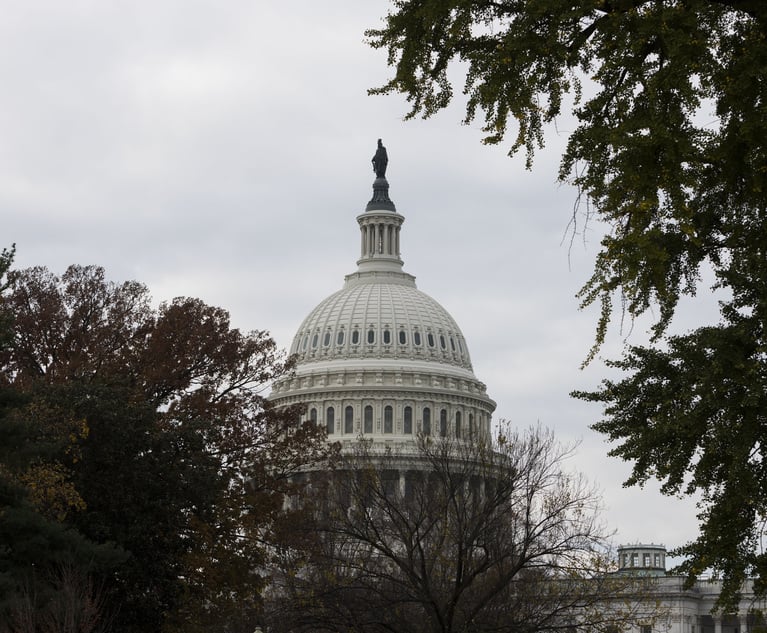The Impact of the SECURE Act on Qualified and Non-Qualified Annuities
The Setting Every Community Up for Retirement Enhancement (SECURE) Act, which took effect Jan. 1, 2020, makes sweeping changes to rules applicable to certain employer sponsored tax-deferred defined contribution (qualified) plans and to traditional IRAs.
March 25, 2020 at 10:30 AM
10 minute read
 Cozine/Shutterstock.com
Cozine/Shutterstock.com
On Dec. 20, 2019, President Trump signed the Setting Every Community Up for Retirement Enhancement (SECURE) Act into law. The Act, which took effect Jan. 1, 2020, makes sweeping changes to rules applicable to certain employer sponsored tax-deferred defined contribution (qualified) plans and to traditional IRAs. In addition, the Act includes a number of other tax provisions including expanding the scope of Qualified Education Expenses for 529 plans, extending certain tax provisions that were scheduled to sunset, restoring the pre-Tax Cuts and Jobs Act "kiddie tax" rates (back to the parent's marginal rate), providing increased tax credits for employers who offer qualified retirement plans for their employees, extending 401(k) plan eligibility to certain part-time workers, and many other tax provisions. This article will focus on the impact of the Act on qualified and non-qualified annuities.
Because IRAs and employer-sponsored defined contribution plans (such as 401(k)s, 403(b)s, and SEPs), may be funded with qualified annuities, the same rules applicable to traditional IRA and defined contribution plan accounts that hold investment assets other than annuities (such as mutual funds, stocks and bonds, etc.), are also applicable to qualified annuities. In addition, as discussed below, the SECURE Act adds provisions designed to facilitate the offering of annuities as an investment choice in employer-sponsored qualified plans.
Although the SECURE Act contains multiple provisions that will produce tax-favorable results for many Americans, the law makes significant changes to the required minimum distribution (RMD) rules in Section 401of the Act (amending Section 401(a)(9) of the Internal Revenue Code of 1986), which are designed to accelerate the recognition of taxable income for individuals who inherit traditional IRAs and qualified plan accounts. Under the old rules, a qualified (designated) beneficiary (DB), could take RMDs out over their own life expectancy (or over the life expectancy of the oldest beneficiary of a qualifying trust) creating a favorable "stretch" of the RMDs.
For instance, a 20-year-old second, or third generation beneficiary would have been able to stretch the RMDs over his/her life expectancy of 63 years. Those inheriting IRA or qualified plan assets who were not designated beneficiaries had to withdraw amounts within five years of the participant's death if the participant died before his/her required beginning date (i.e., before commencing RMDs), or if the participant died after beginning RMDs then over the remaining life expectancy of the decedent as determined under the Single Life Table. These rules relating to non-designated beneficiaries (NDBs) remain unchanged under the new SECURE Act.
In addition to the two categories of beneficiaries mentioned above (DBs and NDBs), the SECURE Act adds a third category called an eligible designated beneficiary (EDB) who still enjoys much of the "stretch" afforded under the previous rules (IRC Section 401(a)(9)(E)(ii)). The SECURE Act applies to plan participants who die after Dec., 31, 2019, and with a few exceptions for EDBs discussed below, most DBs will be required to take RMDs over a maximum stretch of 10 years. By the end of the tenth year following the year of death, all funds must be withdrawn and subject to tax. However, there is no requirement that the beneficiary take the RMD ratably over the 10 years, so that a beneficiary could wait until the tenth year and withdraw all of the funds at that time if so desired—an option also available to conduit trusts. Nevertheless, the SECURE Act's requirement to withdraw all inherited plan assets within a 10-year period may also push DBs into a higher tax bracket than under the old rules. This change to a 10-year withdrawal requirement for most DBs has been referred to as the "death of the stretch" which effectively eviscerates a mainstay of estate and financial planning designed to maximize the time over which RMD's are required to be taken. The additional tax-deferral and compounding of investment returns afforded under the old rules are now significantly curtailed by the SECURE Act. However, in the case of account owners who die between the ages of 72 and 80, and have already begun taking RMDs, the distribution period for NDBs is actually longer than the 10-year period applicable to DBs.
As mentioned above, the SECURE Act added a third category of beneficiary under an IRA or qualified plan referred to as an EDB, which provides for a few limited exceptions to the mandated 10-year period for five beneficiary subcategories. Spouses of the deceased plan participant may continue to take RMDs over their remaining life expectancy and also are still permitted to "roll over" the plan funds into their own IRA. In addition to spouses, there are four other categories of EDBs: (1) disabled beneficiaries; (2) chronically ill beneficiaries; (3) individuals who are not more than 10 years younger than the decedent; and (4) certain minor children of the plan participant, but only until the minor child reaches the age of majority, which may vary depending upon the state of domicile.
Only minor children of the original retirement account owner may take inherited RMDs over their life expectancy, but once they reach the age of majority, they must take the balance of the plan assets out over the next 10 years. This means that prior planning to maximize the stretch of inherited IRAs and plan assets by naming grandchildren as designated beneficiaries, or conduit trusts (also called see through trusts) designed with that goal in mind, are no longer feasible.
Section 401(b)(4) of the Act provides an exception for existing qualified annuity contracts to the new RMD rules for participants who have already begun payments under their annuity before enactment of the Act and are contractually bound (an irrevocable election) to their annuity distribution choice. Therefore these annuity participants may continue taking their payments as selected.
New Section 114 of the Act changes the age for which RMD's must commence (the required beginning date) from age 70½ to age 72. Furthermore, plan participants may also take their first RMD by April 1 after the year they turn age 72 as under the prior law, providing additional limited tax deferral for those who can afford to wait until age 72 to commence taking their RMDs.
In addition, Section 107 of the SECURE Act repealed the law prohibiting contributions to traditional IRAs once a participant reaches age 70½ so that now as long as an individual has earned income, he or she can continue making contributions to their IRA.
Section 204 of the SECURE Act creates a new safe harbor for qualified plan fiduciaries to choose annuity providers and offer a lifetime income (annuity) option as an investment choice to plan participants. The new provisions are designed to shield plans from fiduciary liability if they meet the safe harbor requirements of new Section 404(e) of ERISA. It should be noted that there is no requirement to select the lowest cost.
Section 109 of the Act provides for portability of a plan participant's annuity contract. In the event a plan discontinues an annuity option, plan participants can transfer their annuity contract to another plan or an IRA. This provides a measure of portability to the plan participant so they can transfer their annuity, continue the tax deferral, and help avoid any potential surrender charges and penalties.
Section 203 of the Act requires that at least annually, benefit statements provided to defined contribution plan participants must include a disclosure that shows the total benefits accrued in the form of a lifetime income stream equivalent. According to the Act, this is "the amount of monthly payments the participant or beneficiary would receive if the total accrued benefits of such participant or beneficiary were used to provide lifetime income streams … [through a] qualified joint and survivor annuity … and a single life annuity." (Sec. 203(b)).
Section 113 of the Act created a new exception to the 10% early withdrawal penalty (for withdrawing IRA or plan funds prior to the participant attaining age 59½) of up to $5,000 to help cover the costs of childbirth or adoption expenses. Furthermore, repayment is permitted.
Non-qualified annuities, which are funded with after tax dollars, are subject to a different set of tax rules. RMDs do not apply to these products and earnings are tax-deferred until withdrawn. The non-deductible contributions of non-qualified annuities are recoverable tax-free over the term of the annuity using an exclusion ratio. This is the ratio the total investment in the annuity bears to the total expected payments under the contract. Additionally, non-qualified annuities are subject to the 10% early withdrawal penalty on the taxable portion of distributions received prior to reaching age 59½.
For clients who have existing conduit trusts which pass through each RMD to the designated beneficiary as received to prevent a beneficiary from possibly squandering a large account if left outright (and desiring to preserve the tax benefits of the stretch), should consider the impact of the SECURE Act on their plan. An accumulation trust, which accumulates RMD payments, may better meet the planning need, although possibly at a higher income tax cost given the compressed income tax rates of trusts compared to individuals. In addition, if the client has charitable intent, a charitable remainder trust (CRT) may provide several tax advantages to the client as the payments are then governed by the CRT rules.
There is one novel provision (Reg. 1.401(a)(9)-6) added in 2014 that was unchanged by the SECURE Act, which provides for a qualified longevity annuity contract. This provision permits the greater of 25% of a retirement account, or $125,000 to be excluded from the RMD calculation until the annuitant reaches age 85. This strategy will only yield tax savings for individuals expected to live into their late 80s.
Given the extreme volatility in the stock market recently due to concerns over the domestic and global economic impact of the coronavirus, employees may appreciate having the choice of an appropriate guaranteed lifetime income option (annuity) as an additional investment choice in their defined contribution plans. By establishing a safe harbor rule for plan fiduciaries, the SECURE Act has made the possibility of that choice more likely.
The changes brought by the SECURE Act may significantly impact existing tax, retirement, and estate planning strategies. In some limited circumstances, there may also be a tax refund opportunity for a prior year. Therefore it is important for clients to review their existing estate and retirement plans, and consult with their tax and estate planning counsel and advisers.
Ernest H. Ehling Jr. and Richard Marmon are of c ounsel to Reger Rizzo & Darnall's Mt. Laurel office, serving as members of the firm's Estates & Trusts, Corporate & Business Services, and Business Succession Planning Groups.
This content has been archived. It is available through our partners, LexisNexis® and Bloomberg Law.
To view this content, please continue to their sites.
Not a Lexis Subscriber?
Subscribe Now
Not a Bloomberg Law Subscriber?
Subscribe Now
NOT FOR REPRINT
© 2025 ALM Global, LLC, All Rights Reserved. Request academic re-use from www.copyright.com. All other uses, submit a request to [email protected]. For more information visit Asset & Logo Licensing.
You Might Like
View All


'You Became a Corrupt Politician': Judge Gives Prison Time to Former Sen. Robert Menendez for Corruption Conviction
5 minute readLaw Firms Mentioned
Trending Stories
- 1Parties’ Reservation of Rights Defeats Attempt to Enforce Settlement in Principle
- 2ACC CLO Survey Waves Warning Flags for Boards
- 3States Accuse Trump of Thwarting Court's Funding Restoration Order
- 4Microsoft Becomes Latest Tech Company to Face Claims of Stealing Marketing Commissions From Influencers
- 5Coral Gables Attorney Busted for Stalking Lawyer
Who Got The Work
J. Brugh Lower of Gibbons has entered an appearance for industrial equipment supplier Devco Corporation in a pending trademark infringement lawsuit. The suit, accusing the defendant of selling knock-off Graco products, was filed Dec. 18 in New Jersey District Court by Rivkin Radler on behalf of Graco Inc. and Graco Minnesota. The case, assigned to U.S. District Judge Zahid N. Quraishi, is 3:24-cv-11294, Graco Inc. et al v. Devco Corporation.
Who Got The Work
Rebecca Maller-Stein and Kent A. Yalowitz of Arnold & Porter Kaye Scholer have entered their appearances for Hanaco Venture Capital and its executives, Lior Prosor and David Frankel, in a pending securities lawsuit. The action, filed on Dec. 24 in New York Southern District Court by Zell, Aron & Co. on behalf of Goldeneye Advisors, accuses the defendants of negligently and fraudulently managing the plaintiff's $1 million investment. The case, assigned to U.S. District Judge Vernon S. Broderick, is 1:24-cv-09918, Goldeneye Advisors, LLC v. Hanaco Venture Capital, Ltd. et al.
Who Got The Work
Attorneys from A&O Shearman has stepped in as defense counsel for Toronto-Dominion Bank and other defendants in a pending securities class action. The suit, filed Dec. 11 in New York Southern District Court by Bleichmar Fonti & Auld, accuses the defendants of concealing the bank's 'pervasive' deficiencies in regards to its compliance with the Bank Secrecy Act and the quality of its anti-money laundering controls. The case, assigned to U.S. District Judge Arun Subramanian, is 1:24-cv-09445, Gonzalez v. The Toronto-Dominion Bank et al.
Who Got The Work
Crown Castle International, a Pennsylvania company providing shared communications infrastructure, has turned to Luke D. Wolf of Gordon Rees Scully Mansukhani to fend off a pending breach-of-contract lawsuit. The court action, filed Nov. 25 in Michigan Eastern District Court by Hooper Hathaway PC on behalf of The Town Residences LLC, accuses Crown Castle of failing to transfer approximately $30,000 in utility payments from T-Mobile in breach of a roof-top lease and assignment agreement. The case, assigned to U.S. District Judge Susan K. Declercq, is 2:24-cv-13131, The Town Residences LLC v. T-Mobile US, Inc. et al.
Who Got The Work
Wilfred P. Coronato and Daniel M. Schwartz of McCarter & English have stepped in as defense counsel to Electrolux Home Products Inc. in a pending product liability lawsuit. The court action, filed Nov. 26 in New York Eastern District Court by Poulos Lopiccolo PC and Nagel Rice LLP on behalf of David Stern, alleges that the defendant's refrigerators’ drawers and shelving repeatedly break and fall apart within months after purchase. The case, assigned to U.S. District Judge Joan M. Azrack, is 2:24-cv-08204, Stern v. Electrolux Home Products, Inc.
Featured Firms
Law Offices of Gary Martin Hays & Associates, P.C.
(470) 294-1674
Law Offices of Mark E. Salomone
(857) 444-6468
Smith & Hassler
(713) 739-1250







